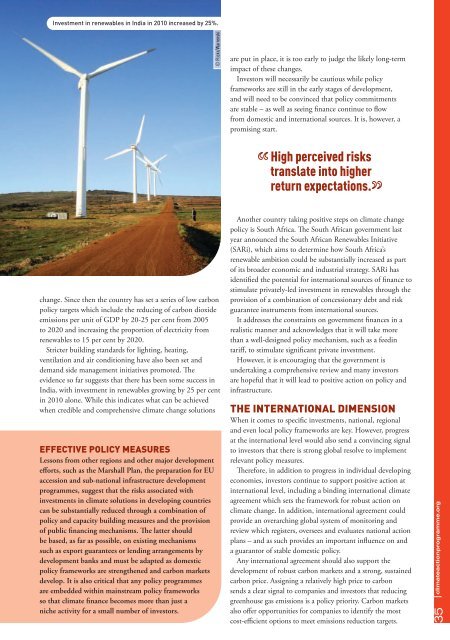Climate Action 2011-2012
You also want an ePaper? Increase the reach of your titles
YUMPU automatically turns print PDFs into web optimized ePapers that Google loves.
Investment in renewables in India in 2010 increased by 25%.<br />
© Flickr/Warrenski<br />
are put in place, it is too early to judge the likely long-term<br />
impact of these changes.<br />
Investors will necessarily be cautious while policy<br />
frameworks are still in the early stages of development,<br />
and will need to be convinced that policy commitments<br />
are stable – as well as seeing finance continue to flow<br />
from domestic and international sources. It is, however, a<br />
promising start.<br />
High perceived risks<br />
translate into higher<br />
return expectations.<br />
change. Since then the country has set a series of low carbon<br />
policy targets which include the reducing of carbon dioxide<br />
emissions per unit of GDP by 20-25 per cent from 2005<br />
to 2020 and increasing the proportion of electricity from<br />
renewables to 15 per cent by 2020.<br />
Stricter building standards for lighting, heating,<br />
ventilation and air conditioning have also been set and<br />
demand side management initiatives promoted. The<br />
evidence so far suggests that there has been some success in<br />
India, with investment in renewables growing by 25 per cent<br />
in 2010 alone. While this indicates what can be achieved<br />
when credible and comprehensive climate change solutions<br />
eFFeCtive PoliCy measures<br />
Lessons from other regions and other major development<br />
efforts, such as the Marshall Plan, the preparation for EU<br />
accession and sub-national infrastructure development<br />
programmes, suggest that the risks associated with<br />
investments in climate solutions in developing countries<br />
can be substantially reduced through a combination of<br />
policy and capacity building measures and the provision<br />
of public financing mechanisms. The latter should<br />
be based, as far as possible, on existing mechanisms<br />
such as export guarantees or lending arrangements by<br />
development banks and must be adapted as domestic<br />
policy frameworks are strengthened and carbon markets<br />
develop. It is also critical that any policy programmes<br />
are embedded within mainstream policy frameworks<br />
so that climate finance becomes more than just a<br />
niche activity for a small number of investors.<br />
Another country taking positive steps on climate change<br />
policy is South Africa. The South African government last<br />
year announced the South African Renewables Initiative<br />
(SARi), which aims to determine how South Africa’s<br />
renewable ambition could be substantially increased as part<br />
of its broader economic and industrial strategy. SARi has<br />
identified the potential for international sources of finance to<br />
stimulate privately-led investment in renewables through the<br />
provision of a combination of concessionary debt and risk<br />
guarantee instruments from international sources.<br />
It addresses the constraints on government finances in a<br />
realistic manner and acknowledges that it will take more<br />
than a well-designed policy mechanism, such as a feedin<br />
tariff, to stimulate significant private investment.<br />
However, it is encouraging that the government is<br />
undertaking a comprehensive review and many investors<br />
are hopeful that it will lead to positive action on policy and<br />
infrastructure.<br />
the international dimension<br />
When it comes to specific investments, national, regional<br />
and even local policy frameworks are key. However, progress<br />
at the international level would also send a convincing signal<br />
to investors that there is strong global resolve to implement<br />
relevant policy measures.<br />
Therefore, in addition to progress in individual developing<br />
economies, investors continue to support positive action at<br />
international level, including a binding international climate<br />
agreement which sets the framework for robust action on<br />
climate change. In addition, international agreement could<br />
provide an overarching global system of monitoring and<br />
review which registers, oversees and evaluates national action<br />
plans – and as such provides an important influence on and<br />
a guarantor of stable domestic policy.<br />
Any international agreement should also support the<br />
development of robust carbon markets and a strong, sustained<br />
carbon price. Assigning a relatively high price to carbon<br />
sends a clear signal to companies and investors that reducing<br />
greenhouse gas emissions is a policy priority. Carbon markets<br />
also offer opportunities for companies to identify the most<br />
cost-efficient options to meet emissions reduction targets.<br />
35 climateactionprogramme.org












